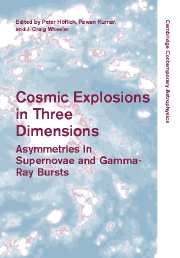Book contents
- Frontmatter
- Contents
- Part I Introduction
- Part II Supernovae: Observations Today
- 2 Supernova explosions: lessons from spectropolarimetry
- 3 Spectropolarimetric observations of supernovae
- 4 Observed and physical properties of Type II plateau supernovae
- 5 SN 1997B and the different types of Type Ic supernovae
- 6 Near-infrared spectroscopy of stripped-envelope supernovae
- 7 Morphology of supernova remnants
- 8 The evolution of supernovae in the winds of massive stars
- 9 Types for the galactic supernovae
- Part III Theory of Thermonuclear Supernovae
- Part IV Theory of Core Collapse Supernovae
- Part V Magnetars, N-Stars, Pulsars
- Part VI Gamma-ray Bursts
- Part VII Conference Summary
- References
2 - Supernova explosions: lessons from spectropolarimetry
Published online by Cambridge University Press: 11 August 2009
- Frontmatter
- Contents
- Part I Introduction
- Part II Supernovae: Observations Today
- 2 Supernova explosions: lessons from spectropolarimetry
- 3 Spectropolarimetric observations of supernovae
- 4 Observed and physical properties of Type II plateau supernovae
- 5 SN 1997B and the different types of Type Ic supernovae
- 6 Near-infrared spectroscopy of stripped-envelope supernovae
- 7 Morphology of supernova remnants
- 8 The evolution of supernovae in the winds of massive stars
- 9 Types for the galactic supernovae
- Part III Theory of Thermonuclear Supernovae
- Part IV Theory of Core Collapse Supernovae
- Part V Magnetars, N-Stars, Pulsars
- Part VI Gamma-ray Bursts
- Part VII Conference Summary
- References
Summary
Abstract
Supernovae can be polarized by an asymmetry in the explosion process, an off-center source of illumination, scattering in an envelope distorted by rotation or a binary companion, or scattering by the circumstellar dust. Careful polarimetry should thus provide insights to the nature of supernovae. Spectropolarimetry is the most powerful tool to study the 3-D geometry of supernovae. A deep understanding of the 3-D geometry of SNe is critical in using them for calibrated distance indicators.
Introduction
Polarimetry of supernovae (SNe) reveals the intrinsic ejecta asymmetries (Shapiro & Sutherland 1982, McCall 1984, Höflich 1991, 1996). SN 1987A represented a breakthrough in this area, by providing the first detailed record of the spectropolarimetric evolution (e.g. Mendez et al. 1988; Cropper et al. 1988). SN 1993J also provided a wealth of data (Trammell, Hines, & Wheeler 1993; Tran et al. 1997). Most of the theoretical interpretations of the polarimetry data are based on oblate or prolate spheroid geometries. A very different picture of SN polarization is discussed in Wang & Wheeler (1996) where time-dependent dust scattering is shown to be a potential mechanism. New attempts are being made with more complicated geometrical structures (Kasen et al. 2003; 2004).
We started a systematic program of supernova spectropolarimetry in 1995 using the 2.1 meter telescope of the McDonald Observatory which nearly doubled the number of SNe with polarimetry measurements in the first year of the program.
- Type
- Chapter
- Information
- Cosmic Explosions in Three DimensionsAsymmetries in Supernovae and Gamma-Ray Bursts, pp. 17 - 29Publisher: Cambridge University PressPrint publication year: 2004
References
- 1
- Cited by



